Bath toys are fun and entertaining for kids, but they can get dirty quickly. They spend a lot of time in warm, soapy water, which makes them a perfect place for mold and bacteria to grow. That’s why it’s important to know How to Clean Bath Toys properly. Regular cleaning helps prevent germs from spreading and keeps your child safe while they play.
Have you ever thought about what might be lurking inside your child’s bath toys? Mold can easily grow inside toys that have small holes or cracks, especially if they aren’t dried out completely. Learning How to Clean Bath Toys properly is not only about cleanliness but also about protecting your little ones from harmful bacteria. Keep reading to find out simple methods you can use to keep those toys clean and fresh!
To properly clean bath toys, you don’t need any fancy supplies. Common household items like vinegar, baking soda, or bleach can work wonders in removing mold and disinfecting the toys. Make sure to rinse them well after each bath and dry them thoroughly to avoid any moisture buildup. By cleaning bath toys regularly, you can keep bath time both fun and safe for your child.
Why Do We Need to Clean Bath Toys?
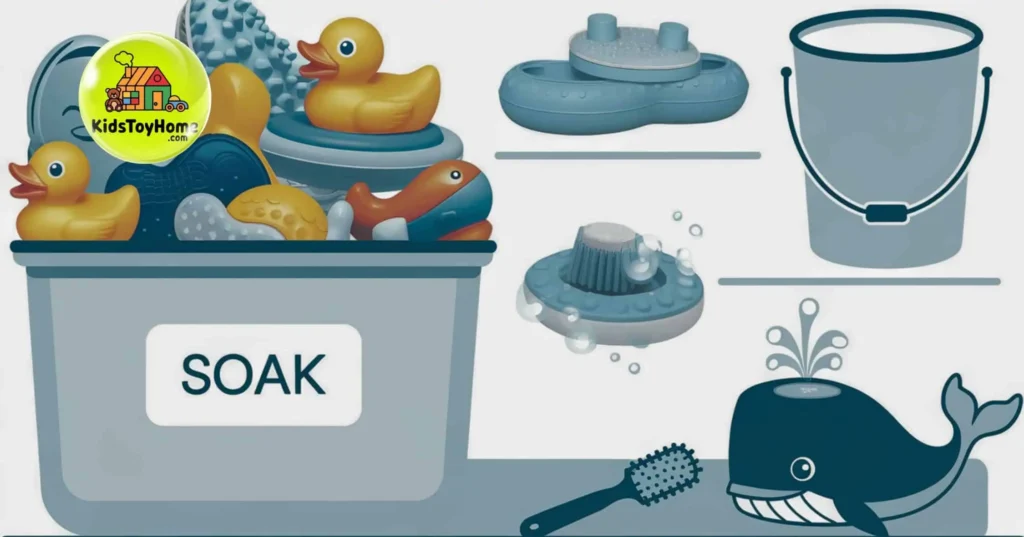
Ever wonder why those colorful bath toys seem to develop a funky smell or slimy texture over time? It’s not just your imagination playing tricks on you. The warm, moist environment of the bathroom is a paradise for mold growth and bacterial buildup. These microscopic invaders love to set up camp inside your child’s favorite tub-time companions, potentially putting your little one’s health at risk.
While most children’s immune systems can handle a bit of everyday grime, some kids may be more susceptible to the effects of mold and bacteria. Exposure to these unwelcome guests can lead to respiratory issues, skin irritations, or even more serious infections in some cases. By making toy cleaning a regular part of your bath time routine, you’re not just tidying up – you’re actively boosting your child’s immunity and protecting their overall health.
How Often Should You Clean Bath Toys?
When it comes to cleaning methods for bath toys, consistency is key. But how often is often enough? As a general rule of thumb, aim to give those rubber duckies and plastic boats a thorough cleaning at least once a week. This frequency helps prevent the buildup of mold spores and bacteria before they can become a problem.
However, keep in mind that some factors might necessitate more frequent cleanings. If your child has been sick, or if you notice any visible signs of mold or an odd smell coming from the toys, it’s time for an immediate deep clean. Additionally, toys with holes that trap water should be emptied and dried after each use to prevent mildew from forming. By incorporating quick daily maintenance into your bath habits, you’ll make the weekly deep clean much easier and more effective.
How to Clean Bath Toys: 6 Full Proof Methods
Keeping bath toys clean is essential for your child’s health and safety. Here are 6 foolproof methods to remove mold, germs, and dirt effectively from bath toys.
1. Clean with Bleach
One of the most effective ways to sanitize toys is by using a bleach solution. This chemical cleaning method is particularly useful for toys with stubborn mold or those that haven’t been cleaned in a while. To create a safe cleaning solution, mix 1/2 cup of bleach with 1 gallon of water. Submerge the toys in this mixture for about 5-10 minutes, then rinse thoroughly with clean water and allow to air dry completely.
While bleach is excellent for mold removal, it’s important to handle it with care. Always work in a well-ventilated area and wear gloves to protect your skin. After cleaning, make sure to rinse the toys multiple times to remove any residual bleach before giving them back to your child. This method is great for a deep clean, but shouldn’t be used too frequently as it can degrade certain materials over time.
2. Wash with Vinegar
For those who prefer a more natural cleaner, vinegar is an excellent option. This eco-friendly clean method harnesses the power of acetic acid to kill bacteria and remove mold. Create a vinegar solution by mixing equal parts white vinegar and warm water. Soak the toys in this mixture for about 15-20 minutes, then scrub gently with a brush or cloth to remove any remaining grime.
After the vinegar soak, rinse the toys thoroughly with clean water and allow them to air dry. This method is gentler on toys and safer for children who might be sensitive to harsher chemicals. Plus, it leaves behind a fresh, clean scent without the strong odor associated with bleach cleaning.
3. Disinfect with Hydrogen Peroxide
Hydrogen peroxide is another effective option for sanitizing bath toys. It’s particularly good at killing bacteria and removing mold without leaving behind harmful residues. To use this method, fill a bowl or sink with equal parts hydrogen peroxide and water. Submerge the toys in this solution for about 10 minutes, then rinse thoroughly and dry completely.
This method is especially useful for toys with small crevices or hard-to-reach areas where mold likes to hide. The bubbling action of hydrogen peroxide helps to lift dirt and grime from these spots, making it easier to achieve a thorough clean. As with any cleaning method, always ensure the toys are completely dry before returning them to your child’s toy collection.
4. Put Bath Toys Through the Dishwasher
For busy parents looking for a hands-off approach, the dishwasher can be a lifesaver when it comes to cleaning options. Many plastic and rubber bath toys are dishwasher safe, making this an easy and effective cleaning method. Place the toys on the top rack of your dishwasher, away from the heating element, and run them through a hot cycle without detergent.
The high temperatures reached during a dishwasher’s washing cycle are excellent for killing germs and bacteria. However, not all toys are suitable for this method. Check the manufacturer’s instructions before putting any toys in the dishwasher, and avoid using this method for toys with batteries or electronic components. After the cycle is complete, remove the toys promptly and allow them to air dry completely before returning them to the bathtub.
5. Soak in Hot Water
Sometimes, the simplest solutions are the most effective. A hot water soak can work wonders for cleaning bath toys, especially when combined with a mild soap or vinegar. Fill your sink or a large bowl with warm water as hot as you can comfortably touch (around 110°F to 120°F). Add a few drops of dish soap or a cup of white vinegar, then submerge the toys and let them soak for 15-20 minutes.
After the soak, use a soft brush or cloth to scrub away any remaining dirt or mold. Rinse the toys thoroughly with clean water and dry them completely. This method is gentle enough to use regularly and can be a great way to maintain cleanliness between deeper cleanings. The heat cleaning helps to kill bacteria and loosen any grime, making it easier to keep your child’s bath toys in top condition.
6. Use Disinfectant Wipes
For a quick and easy cleaning solution, disinfectant wipes can be a parent’s best friend. These handy wipes are perfect for giving bath toys a quick once-over between more thorough cleanings. Simply wipe down each toy with a disinfectant wipe, paying special attention to any crevices or textured areas where dirt might accumulate.
After wiping, rinse the toys with clean water to remove any residue from the wipes, then allow them to air dry completely. While this method is great for bacteria removal and maintaining cleanliness, it’s not as effective for removing deep-set mold or grime. Use this as part of your regular maintenance routine, but still plan for deeper cleanings using one of the other methods mentioned above.
Preventing Mold Growth on Bath Toys
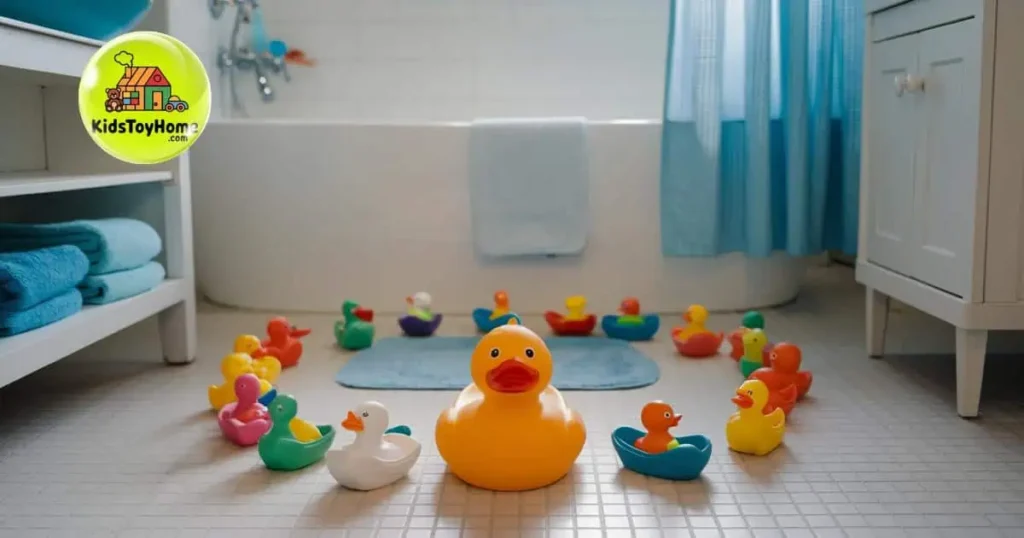
Plug the Holes
One of the biggest culprits for mold growth in bath toys is trapped water. Many squeezable toys have small holes that allow them to squirt water, but these openings can also trap moisture inside, creating the perfect environment for mold to thrive. To combat this, consider plugging these holes with a dab of hot glue or silicone sealant. This simple step can significantly reduce the risk of mold formation inside the toys.
Drain the Toys
After each bath, make it a habit to squeeze out as much water as possible from any toys that retain water. This includes rubber ducks, squirt toys, and any other hollow toys. By removing excess water, you’re eliminating the moist environment that mold and bacteria need to grow. You can even create a fun game out of this process, encouraging your kids to help “drain” their toy friends after each bath.
Dry the Toys
Proper drying is crucial in mold prevention. After each use, rinse the toys with clean water to remove any soap residue, then shake off excess water. Set up a drying station in your bathroom – this could be a dish rack, a mesh bag, or even a dedicated toy drying tree. Ensure the toys are stored in a well-ventilated area where air can circulate freely around them. This simple step can go a long way in keeping those bath buddies clean and mold-free.
How to Pick Easy-to-Clean Toys for Bathtime
When shopping for bath toys, keep cleanliness in mind. Look for toys made from mold-resistant materials like silicone or rubber. Avoid toys with small, hard-to-reach crevices where mold can hide. Opt for toys that can be easily opened and cleaned, or those without any openings at all. Some modern bath toys are designed with mold prevention in mind, featuring removable parts or antimicrobial materials.
Consider the balance between fun and practicality. While a complex, multi-part toy might seem exciting, it could be a nightmare to clean. Simple shapes like boats, stacking cups, or water wheels can be just as entertaining and much easier to maintain. Remember, the best bath toy is one that’s both fun for your child and easy for you to keep clean and hygienic.
Other Methods & Tips
In addition to the cleaning methods mentioned above, there are other innovative ways to keep bath toys clean. UV light sanitizers, for example, can be an effective way to kill bacteria without the use of chemicals. Some parents swear by boiling toys (for those that can withstand high temperatures) or using the sanitize cycle on their washing machine for fabric toys.
When it comes to storage, consider using a mesh bag or basket that allows toys to drain and air dry between uses. Rotating toys can also be helpful – keep a set out for a week, then switch them out for a clean set while you thoroughly clean the first batch. This not only helps maintain cleanliness but also keeps bath time interesting with “new” toys each week.
Should You Get Rid of Your Child’s Bath Toys?
While regular cleaning can keep most bath toys in good condition, there comes a time when some toys may need to be retired. If you notice persistent mold growth, strong odors that don’t go away after cleaning, or any deterioration in the toy’s material, it’s time to say goodbye. Cracks or breaks in toys can harbor bacteria and make thorough cleaning impossible.
It’s also worth considering the age and interests of your child. As they grow, their bath time needs and preferences may change. Use this as an opportunity to introduce new, age-appropriate toys that are easier to clean and more engaging for your child’s current developmental stage. Remember, a clean and safe bath environment is more important than holding onto old, potentially harmful toys.
Why Are My Child’s Bath Toys Moldy?
If you’re consistently finding mold on your child’s bath toys, several factors could be at play. High humidity in the bathroom, lack of ventilation, and infrequent cleaning are common culprits. Toys with small holes or crevices are particularly prone to mold growth, as they can trap water and provide a perfect breeding ground for fungus and bacteria.
To combat this issue, improve bathroom ventilation by using exhaust fans or opening windows after baths. Implement a regular cleaning and drying routine for the toys, and consider using mold-resistant toys or those designed for easy cleaning. Remember, prevention is key – by addressing the root causes of mold growth, you can keep your child’s bath toys clean and safe for longer periods.
About Molly Maid
Molly Maid is a professional cleaning service that understands the importance of maintaining a clean and healthy home environment, especially in areas like bathrooms where moisture and bacteria can thrive. With years of experience in tackling tough cleaning challenges, Molly Maid offers expert services to keep your home sparkling clean and hygienic.
Their team of trained professionals uses effective cleaning techniques and products to ensure that every nook and cranny of your bathroom, including those hard-to-reach areas where bath toys might be stored, is thoroughly cleaned and sanitized. By entrusting your home cleaning to Molly Maid, you can have peace of mind knowing that your living space is not only clean but also healthier for your family.
Find a Molly Maid Near Me
Looking for professional help to keep your bathroom and the rest of your home in tip-top shape? Molly Maid has locations across the country, making it easy to find a reliable cleaning service near you. To locate your nearest Molly Maid, simply visit their website and use their convenient location finder tool. Enter your zip code, and you’ll be presented with the closest Molly Maid service providers in your area.
By choosing Molly Maid, you’re not just getting a cleaning service – you’re investing in your family’s health and well-being. Their professional cleaners can help maintain a hygienic environment in your bathroom and throughout your home, giving you more time to focus on what really matters – enjoying quality time with your family, including those fun bath time moments with your little ones.
FAQs
How often should I clean my child’s bath toys?
It’s best to clean bath toys thoroughly once a week. However, you should rinse and dry them after each use to prevent mold growth. If you notice any visible mold or strange smells, clean the toys immediately.
Is it safe to use bleach to clean bath toys?
Yes, using a diluted bleach solution is safe and effective for cleaning bath toys. Mix 1/2 cup of bleach with 1 gallon of water. Soak the toys for 5-10 minutes, then rinse thoroughly and air dry. Always ensure all bleach residue is removed before giving the toys back to your child.
Can I put bath toys in the dishwasher?
Many plastic and rubber bath toys are dishwasher safe. Place them on the top rack and run a hot cycle without detergent. Always check the manufacturer’s instructions first, and avoid putting toys with batteries or electronic components in the dishwasher.
What’s the best way to prevent mold growth on bath toys?
To prevent mold growth, drain water from the toys after each use, dry them thoroughly, and store them in a well-ventilated area. You can also plug holes in squeeze toys to prevent water from getting trapped inside. Regular cleaning and proper storage are key to preventing mold.
When should I replace my child’s bath toys?
Replace bath toys if you notice persistent mold growth, strong odors that don’t go away after cleaning, or any signs of material deterioration like cracks or breaks. It’s also a good idea to replace toys as your child grows and their interests change, opting for age-appropriate toys that are easier to clean.
Conclusion
Keeping bath toys clean is super important for your child’s health and fun bath times. We’ve learned lots of ways to clean bath toys, like using bleach, vinegar, or even putting them in the dishwasher. Remember to clean the toys often and dry them well after each use. This stops yucky mold from growing on them. You can also pick toys that are easy to clean when you go shopping.
How to clean bath toys doesn’t have to be hard. You can make it a fun activity with your kids. Try different cleaning methods to see what works best for you. Always check toys for damage and replace them if needed. By following these tips, you’ll make sure bath time is safe and enjoyable for your little ones. Clean toys mean happy, healthy kids.

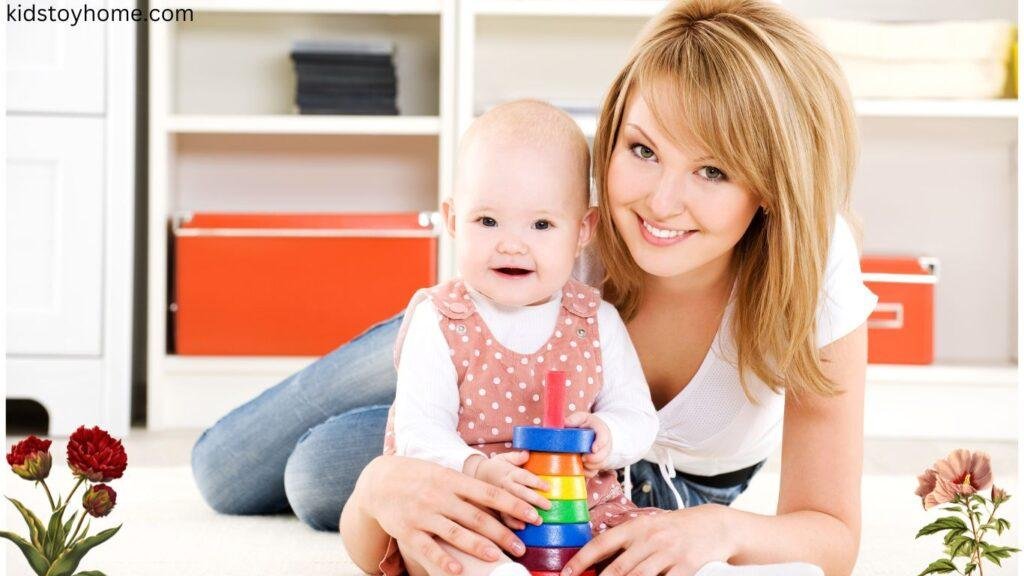
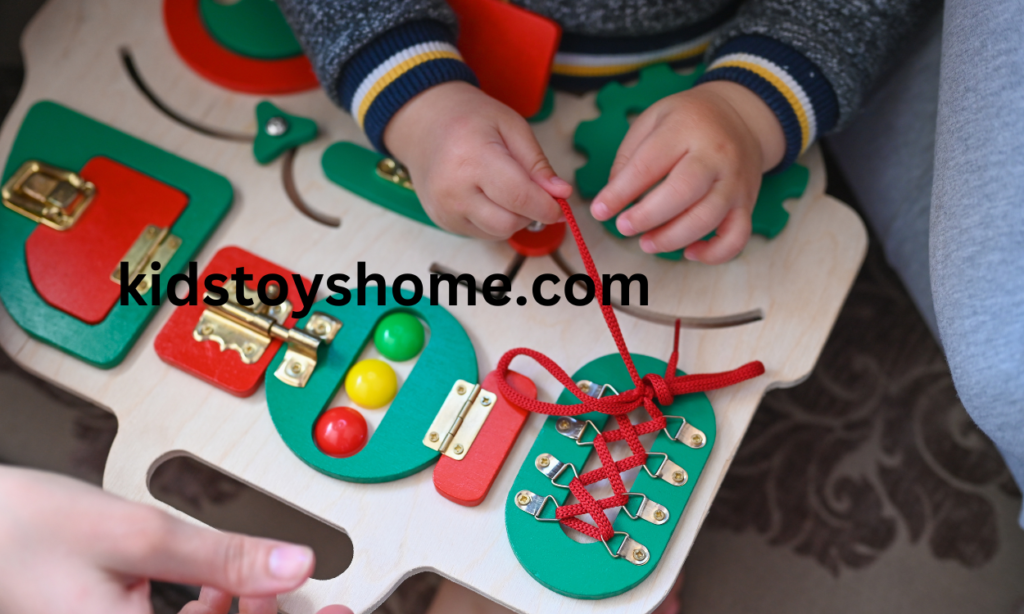
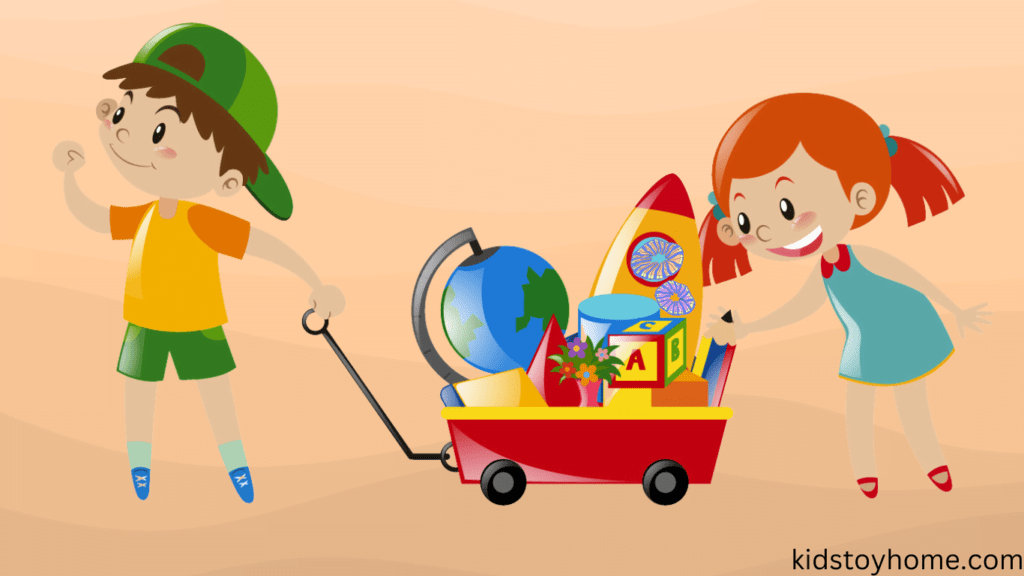
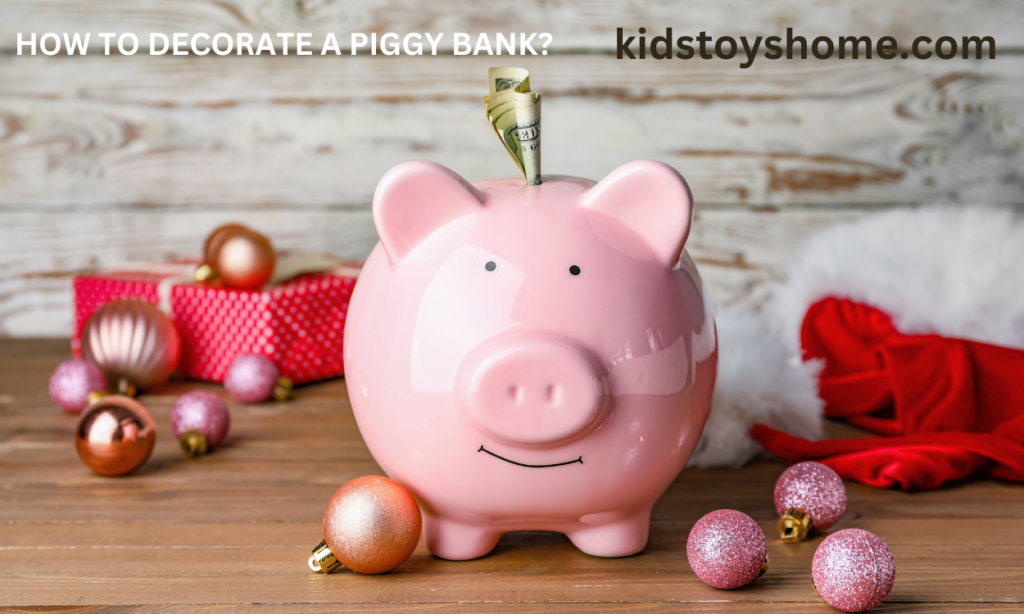

Wonderful web site. A lot of useful info here. I am sending it to several friends ans also sharing in delicious. And certainly, thanks for your sweat!